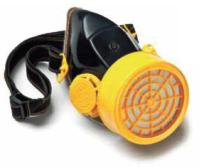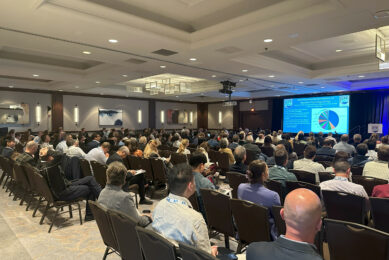Reducing the health hazard of dust in feed processing

Exposure to dust from raw materials takes on special importance since almost all products used in the animal feed industry are in powder form. Many of them (in particular the feed additives) are chemical compounds and biological agents which have both acute and long-term toxic effects which include, in many cases the capacity to cause skin and respiratory sensitisation. This article shows that granulation proves to be a good method to reduce exposure to dust in the workplace.
Feed additives form a (respiratory) hazard for workers in a feed mill. The legal category “feed additive” comprises, amongst others, all of the trace element metals, nutritional additives, zootechnical additives and also a range of additives performing technological functions. Feeds are also a common vehicle for the administration of veterinary medicines and therefore worker exposure to medicinal compounds, in particular antibiotics, is also a consideration. For example, some cobalt salts have recently been classified by the EU as carcinogenic for humans, manganese compounds present some very specific and unusual toxicological hazards and virtually all of the enzyme and probiotic feed additives will be classified as potential sensitising agents. Also in feed processing, exposure to complex mixtures of potentially harmful compounds may occur. Therefore, synergistic effects cannot be discounted and often due to the complexity of the mixtures concerned, cannot even be predicted. As well as the potential for acute exposure incidents there is a higher potential for long-term exposure to low levels of hazardous compounds. Finally, many of the chemical agents contained in animal feed powders may have a role in possible endocrine disruption and this also cannot be discounted.
Few health hazard data
Given the above, and with the exception of rare cases of accidental acute intoxication, Italian health statistics do not clearly show the epidemiology of the toxicological pathology of feed industry chemical exposure and in fact there is no INAIL (Italian institute of occupational accidents) data in this field. Despite this, and as a result of the growing use of different ingredients and the possibilities for absorbing xenobiotics, above all through the respiratory tract, there is a high probability that adverse biological effects occur in the feed industry working population. These effects are, in the main, sub-clinical in nature, spread out over time, and lack specific disease classification and are therefore difficult to detect in the field of occupational epidemiology.The animal feed production process can be divided in four stages where hazards could occur:
Given the above, and with the exception of rare cases of accidental acute intoxication, Italian health statistics do not clearly show the epidemiology of the toxicological pathology of feed industry chemical exposure and in fact there is no INAIL (Italian institute of occupational accidents) data in this field. Despite this, and as a result of the growing use of different ingredients and the possibilities for absorbing xenobiotics, above all through the respiratory tract, there is a high probability that adverse biological effects occur in the feed industry working population. These effects are, in the main, sub-clinical in nature, spread out over time, and lack specific disease classification and are therefore difficult to detect in the field of occupational epidemiology.The animal feed production process can be divided in four stages where hazards could occur:
- Preparation of more or less concentrated agents.
- Preparation of premixtures.
- Mixing of raw materials with premixtures.
- Feeding at farm sometimes in combination with farm grown ingredients.
Each stage involves a degree of manual handling depending on the size of the operation and the automation involved and whilst each successive stage involves a dilution of potentially toxic principles it has been shown that this does not necessarily reduce the risk of exposure.
Indentifying risks
Despite considerable variability, the degree of exposure to dust and xenobiotics (for example manganese), is greatest within the premixture industry and considerably lower within the feed production and livestock feeding sectors.
Despite considerable variability, the degree of exposure to dust and xenobiotics (for example manganese), is greatest within the premixture industry and considerably lower within the feed production and livestock feeding sectors.
Studies also demonstrate that in the animal feed industry, 40% of the total inhalable dust comprises respirable dust, i.e. dust, which by virtue of its small particle size, is capable of reaching the deep lung tissue and may therefore subject to a degree of systemic absorption. In the case of manganese almost 60% of the dust is classified as respirable and therefore potentially absorbable. Observations recorded in France largely concur with these findings.
It can be concluded therefore that whilst the Italian working environment remains conducive to potential exposure to toxic substances, innovations in equipment and manufacturing technologies and increased scrutiny of the compounds used and the forms in which they are incorporated by the regulatory authorities has improved the situation. These observations also appear to agree with those from similar studies conducted in France.
Dust categories
The granular dimensions of dust, or the equivalent aerodynamic diameter, affect the potential for deposition in the respiratory tract and as a result regulation UNI-EN 481/94 categorises dusts into the following fractions:
The granular dimensions of dust, or the equivalent aerodynamic diameter, affect the potential for deposition in the respiratory tract and as a result regulation UNI-EN 481/94 categorises dusts into the following fractions:
Inhalable dust: the fraction by mass of the total particles which are inhaled by mouth or nose and which contain at least 50% of particles with an aerodynamic diameter in excess of 100 microns. Inhalable dust comprises the upper-thoracic fraction (particles of a dimension ranging between 7 and 10 microns which do not pass beyond the larynx) and the thoracic fraction (particles of a dimension ranging between 7 and 4.5 microns which do not pass beyond the ciliated part of the lower respiratory tract); Respirable dust: a proportion consisting of at least 50% of the particles with an aerodynamic diameter lower than 5 microns which, by escaping the defensive action of the ciliate system of the respiratory tract, may penetrate as far as the pulmonary alveoli, causing both local phenomena and resulting in the absorption of any toxic agents contained in them.
In recent years a number of specially prepared products (so-called technological pre-mixes) have been developed in which the active agents are contained within granules of a specific and well-controlled particle size. These products are produced by specific processing techniques, in which the proportion of particles present in a product can be fixed to a diameter greater than 100 microns and dust emissions can be limited to less than 5%. The end result is a finished product with a very low content of fine particles which can have a positive impact on the quality of the animal feed in terms of additive homogeneity and, crucially, in this context, on the likelihood of the dispersion of fine dusts while it is being processed or handled. Research carried out under experimental conditions simulating a feed production cycle has shown how the use of such technological pre-mixes with defined and controlled particle size can significantly reduce the levels of both inhalable and respirable dusts (Figure 1). For example, in the experiment reported in this article the average percentage of respirable dust containing manganese was reduced by more than 30% (Figure 2).
Practical trial
Taking the above into account, an experiment to evaluate the beneficial effects of using technological pre-mixes with controlled particle size was undertaken under real production conditions within a factory producing pre-mixes and feeds for animals in the province of Perugia. The study involved the measurement of dust levels in a number of working environments within the factory in order to evaluate levels of inhalable and respirable dusts. Manganese content of the dusts (one of the active principles of toxicological interest) was also determined.The study investigated dust and manganese pollution in the additive/premixture weighing stations and the packaging stations of a feed producer in Umbria. On the days when the investigation was conducted, the company used a recipe which required the use of granule pre-mixes containing manganese and manganese oxide.
Taking the above into account, an experiment to evaluate the beneficial effects of using technological pre-mixes with controlled particle size was undertaken under real production conditions within a factory producing pre-mixes and feeds for animals in the province of Perugia. The study involved the measurement of dust levels in a number of working environments within the factory in order to evaluate levels of inhalable and respirable dusts. Manganese content of the dusts (one of the active principles of toxicological interest) was also determined.The study investigated dust and manganese pollution in the additive/premixture weighing stations and the packaging stations of a feed producer in Umbria. On the days when the investigation was conducted, the company used a recipe which required the use of granule pre-mixes containing manganese and manganese oxide.
The investigation involved taking air samples, using a special pump with constant flow (precision +/-5%) and anti-low flow mechanism, conforming predefined requirements. The samples were taken at a height of about 150 cm at the respective work stations. In order to study the relationship between the different particle sizes within the dust, a paired sample of inhalable and respirable dust was taken at the same time by positioning the two sampling heads in the same place, 40 cm apart.
Figure 3 shows the average dust concentrations detected at the various workstations and the related statistical comparisons. Figures 4 and 5 show the distribution of the results of the paired samples of inhalable and respirable dust as well as the manganese content of these dusts.
Comment and conclusions
The data obtained confirm that, as far as average dust pollution is concerned, the packaging areas have levels of inhalable and respirable particles, containing manganese, which are significantly higher than those collected in the weighing area. These data suggest that measures aimed at reducing dust emissions at the source should be taken in such a way as to reduce the potential for the formation and/or release, of fine particles.As far as the relationship between inhalable dust and the respirable fraction is concerned, it emerged that the average proportion of the respirable fraction compared to the inhalable was around 12% in all samples. This suggests that a particle size which has a low probability of penetrating the deep respiratory tract is the main issue.
The data obtained confirm that, as far as average dust pollution is concerned, the packaging areas have levels of inhalable and respirable particles, containing manganese, which are significantly higher than those collected in the weighing area. These data suggest that measures aimed at reducing dust emissions at the source should be taken in such a way as to reduce the potential for the formation and/or release, of fine particles.As far as the relationship between inhalable dust and the respirable fraction is concerned, it emerged that the average proportion of the respirable fraction compared to the inhalable was around 12% in all samples. This suggests that a particle size which has a low probability of penetrating the deep respiratory tract is the main issue.
The results of the paired samples are similar. The respirable fraction is around 17% of the inhalable fraction in the case of general dust and around 20% for dust containing manganese. There is a strong relationship in the correlation between the values of inhalable and respirable dust, and a stable and similar relationship between the two sizes of particles.
Clearly, operating in real conditions means that one is unable to completely remove dust residues from previous production, and it is therefore probable that a residue of manganese used in traditional form, with a fine particle size, from the production in the preceding days may have affected the final results, in particular by increasing the proportion of particularly fine dust.
Despite this, when using granule pre-mixes, the average percentage of manganese detected as respirable dust was considerably less than that detected when traditional pre-mixes were used, resulting in an appreciable reduction in the pollution caused by fine particles and consequently the risk of respiratory absorption.
The data confirm that dust emissions remain a workplace hygiene issue for feed producers and that preventive measures should be adopted. The most significant measures will remain: general and localised aspiration systems, equipment maintenance, systematic cleaning of work areas, organisational and behavioural measures (correct use of equipment, personal hygiene etc) and advising and training of the workforce.
Alongside these measures is an approach that reduces the risk of the dust hazard occurring at the source, for example the choice of particle size of raw materials, tends to reduce the release of very small particles, and thus limits the respiratory absorption of any toxicological agent contained in them. In particular, if a treatment can be adopted which modifies the nature of a pre mix particle size (by increasing it) and which has a degree of stability or robustness with respect to the rigors of the processes to which it is subjected it should be considered as a valid and important preventative measure.
*Giorgio Miscetti is specialist in Occupational Medicine and head of UOC Prevention and Safety in the Work Place, University of Perugia. For this research he was assisted by Patrizia Garofani and Lea Romano Gargarella both specialist in Occupational Medicine at the same university and David Pickard who is Regulatory Affairs consultant at DP-Consulting in the UK.











